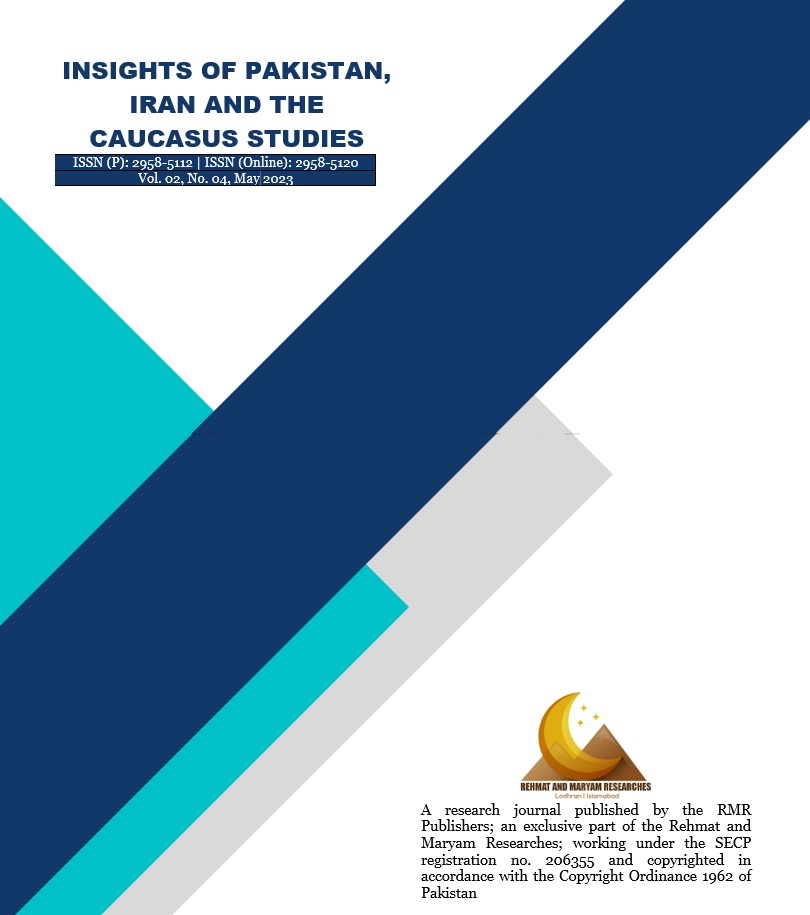A Case-Study of US Intervention in Afghanistan for Eradication of Terrorism and State-Building Processes for Afghanistan; Impacts on Pakistan
Keywords:
US-led War on Terror, KPK, Al-Qaeda, Ayman Al-Zawahri, Saudi Arabia, TanzaniaAbstract
This research paper focuses on the impact of the US intervention in Afghanistan for eradicating terrorism and the state-building processes for Afghanistan, and how it affected Pakistan. State-building is defined as the sustainable development of a state with regards to its economy, politics, institutions, law and order situation of an already existing nation-state. The study raises important questions regarding the US-led international intervention in Afghanistan, its impact on nation-building processes, and its reflection on local autonomy.
The concept of state-building emerged in the twentieth century, primarily due to terrorism and the multifaceted challenges posed by it. Peace, security, institutional setting, and infrastructure stability are critical elements in the state-building process. However, the study highlights that in most cases, the focus is diverted to security concerns while neglecting other aspects, which causes more problems and damage to the cause.
The research paper discusses how the US-led intervention in Afghanistan could help support nation-building processes or further deteriorate the situation. It also explores how the intervention impacted local autonomy. The study is significant in understanding the role of international intervention in nation-building processes and how it affects local autonomy.
References
Biddle, S. D. (2005). American grand strategy after 9/11: An assessment. Strategic Studies Institute.
Carlisle, R. P. (2010). America at War: Afghanistan War. In J. S. Bowman (Ed.), Chelsea House Publishers.
Fukuyama, F. (2006). Nation Building: Beyond Afghanistan and Iraq. The Johns Hopkins University Press.
Junaid, S. (2005). Terrorism and the state. In Terrorism and Global Power System (pp. 73). Oxford University Press.
Maass, C. D. (Ed.). (2007). Assessing the Afghanistan Compact: Is the International Community Defaulting on the Compact or is the Compact the Wrong Approach? In The Afghanistan Challenge: Hard Realities and Strategic Choices (pp. 165-182). Springer.
Runion, M. L. (2007). The History of Afghanistan. Greenwood Press.
Taddeo, V. (2010). U.S. Response to Terrorism: A Strategic Analysis of the Afghanistan Campaign. Journal of Strategic Security, 3(2), 1-20.
Wilkens, A. (2013). Governance Crisis and Institution Building in Afghanistan. In Transition in Afghanistan Post-Exist Scenario: IPRI and HSF Conference (pp. 18-23). Islamabad Policy Research Institute.
Barfield, T. (2010). Afghanistan: A Cultural and Political History. Princeton University Press.
“The 9/11 Commission Report: Executive Summary.” National Commission on Terrorist Attacks Upon The United States, special issue, 1-31.
Smith, B., & Thorp, A. (2010). The Legal Basis for the Invasion of Afghanistan. House of Commons Library, 1-10, papers%2Fsn05340.pdf&ei=0-2qVMuQC8P6Uvu0gaAL&usg=AFQjCNF74roxP7xrDI1-GWilovW0M11KUA.
Resolution 2145 (2014). The United Nations Security Council, 17 March 2014, 1-17.
Abid Ali, L. (2013). Transition in Afghanistan: Imperatives of Handling Internal and External Security Challenges. Islamabad: Islamabad Policy Research Institute.
Carlisle, R. P. (2010). America at War: Afghanistan War. In J. S. Bowman (Ed.), Chelsea House Publishers.
Cordesman, A. H., & Burk, A. A. (2012). The Us Cost of the Afghan War: Fy 2002-Fy 2013. Centre for Strategic and International Studies, Washington DC.
Fukuyama, F. (2006). Nation Building: Beyond Afghanistan and Iraq. The Johns Hopkins University Press.
Greco, R. (2011). Exit from Afghanistan: Strategy Before Schedule. Longitude, 6, 59-61.
Junaid, S. (2005). Terrorism and the State. In Terrorism and Global Power System (pp. 73). Oxford University Press.
Khan, A. N. (2011). The US’ Policy of Drone Attacks in Pakistan. Islamabad Policy Research Institute, 11(1), 21-40.
Kuehn, F. P. (2009). Supporting the State, Depleting the State: Estranged State-Society Relations in Afghanistan. In H. G. Ehrhart & C. C. Pentland (Eds.), The Afghanistan Challenge: Hard Realities and Strategic Choices (pp. 57-77). Queens University at Kingston, Canada: School of Policy Studies.
Maass, C. D. (2009). Assessing the Afghanistan Compact: Is the International Community Defaulting on the Compact or is the Compact the Wrong Approach? In H. G. Ehrhart & C. C. Pentland (Eds.), The Afghanistan Challenge: Hard Realities and Strategic Choices (pp. 207-218). Queens University at Kingston, Canada: School of Policy Studies.
Neumann, P. R., & Smith, M. L. R. (2008). The Strategy of Terrorism: How It Works, and Why It Fails. Routledge.
Reese, S. D., & Lewis, S. C. (2009). Framing the War On Terror: The Internalization of Policy in the Us Press. Journalism, 10(6), 777-797.
Resolution 2145 (2014). (The United Nations Security Council, 17 March 2014).
Rodney, P. C. (2010). America at War: Afghanistan War. In J. S. Bowman (Ed.), Chelsea House Publishers.
Runion, M. L. (2007). The History of Afghanistan. Greenwood Press.
Schetter, C., & Glassner, R. (2009). The Changing Face of Warlordism in Afghanistan. In H. G. Ehrhart & C. C. Pentland (Eds.), The Afghanistan Challenge: Hard Realities and Strategic Choices (pp. 37-57). Queens University at Kingston, Canada: School of Policy Studies.
Taddeo, V. (2010). U. S. Response to Terrorism: A Strategic Analysis of the Afghanistan Campaign. Journal of Strategic Security, 3(2), 1.
“The 9/11 Commission Report: Executive Summary.” (National Commission on Terrorist Attacks Upon The United States). In special issue (pp. 1-31).
Wilkens, A. (2013). Governance Crisis and Institution Building in Afghanistan. In H. G. Ehrhart & C. C. Pentland (Eds.), Transition in Afghanistan Post-Exist Scenario: IPRI and HSF Conference (pp. 18-23). Islamabad: Islamabad Policy Research Institute.
Downloads
Published
Issue
Section
Categories
License
Copyright (c) 2023 Insights of Pakistan, Iran and the Caucasus Studies

This work is licensed under a Creative Commons Attribution-NonCommercial-NoDerivatives 4.0 International License.

